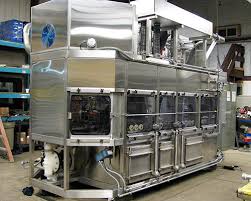|
Getting your Trinity Audio player ready... |
What is a Pharmaceutical Washing Station
Pharmaceutical washing station is a machine designed for cleaning pharmaceutical equipment, such as bins and containers.
What is the Purpose of a Pharmaceutical Washing Station?
- Pharmaceutical washing stations are used for:
- Cleaning various pharmaceutical equipment, like bins and containers.
- Drying different pharmaceutical equipment post-cleaning.
- Ensuring equipment quality is maintained during the cleaning and drying stages.
- Creating an optimal surface for disinfecting the equipment.
What are the Benefits of a Pharmaceutical Washing Station?
When utilizing a pharmaceutical washing station, you’ll experience:
- It operates automatically at high speed, saving time.
- Equipped with a PLC control unit for programming and automating the process.
- Operations can be monitored and controlled from one location.
- Reduces the need for manual labor in cleaning and drying.
- Guarantees high cleaning and drying efficiency, ensuring cleanliness.
- Made from stainless steel, ensuring durability and hygiene.
- Increases productivity by minimizing downtime.
- Safe to use, as you don’t handle hazardous chemicals.
- User-friendly, with easy-to-set operational parameters.
- You can opt for a customized machine.
- Ideal for cleaning heat-sensitive items without causing damage.
- Available in various sizes and capacities.
- Minimal maintenance costs due to low downtime.
Are There Disadvantages to Pharmaceutical Washing Stations?
Some drawbacks include:
- High initial costs, including purchase and installation.
- Skilled labor may be required to operate the machine effectively.
- Requires considerable floor space due to its size.
What Are the Main Components of a Pharmaceutical Washing Station?
A pharmaceutical washing station includes:
- Main Body/Frame: Supports all components, made of high-quality stainless steel for durability.
- Transport Unit: Moves equipment between washing and drying stations.
- Washing System: Includes nozzles, surge tanks, and racks for efficient cleaning.
- Pump System: Provides the pressure needed for water spraying.
- Air Handling System: Supplies air for drying and moisture removal.
- Electrical System: Powers the machine for operation.
- Control System: Allows programming and monitoring via a servo PLC system.
- Safety System: Ensures safety by stopping operations if issues arise.
- Water Heating System: Heats water to the desired temperature for cleaning.
How Does a Pharmaceutical Washing Station Operate?
The process typically follows these steps:
- Preparation: Ensure all equipment and cleaning agents are in place. Load equipment into the machine with proper orientation for optimal cleaning.
- Cleaning: Program cleaning parameters (e.g., speed, water temperature, detergent amount), then activate the machine for cleaning.
- Drying: After cleaning, the equipment moves to the drying station where hot air dries the items. The machine stops once cleaning criteria are met.
What are the Key Cleaning Parameters in a Pharmaceutical Washing Station? Important parameters to control include:
- Cleaning and drying time.
- Water temperature.
- Detergent quality and quantity.
- Air temperature for drying.
What Material Are Pharmaceutical Washing Stations Made From?
Pharmaceutical washing stations are mainly made from Austenitic stainless steel, ensuring strength, durability, and cleanliness.
Which Industries Use Pharmaceutical Washing Stations?
Pharmaceutical washing stations are used in:
- The pharmaceutical industry for cleaning bins and containers.
- The food industry for cleaning food processing equipment.
- The chemical industry for cleaning containers without hazards to workers.
What Quality Standards Must Pharmaceutical Washing Stations Meet?
A quality pharmaceutical washing station should meet:
- cGMP (current good manufacturing practices).
- ISO certification.
- FDA standards for safety and effectiveness.
- CE certification for electrical safety.
How to Specify a Pharmaceutical Washing Station?
To specify a custom machine, you should provide:
- Level of automation (automatic or semi-automatic).
- Dimensions and weight.
- Power requirements for various systems (e.g., pumps, fans).
- Pressure and flow rates, as well as fan power.
What Can You Clean in a Pharmaceutical Washing Station?
The washing station can clean:
- Pharmaceutical bins.
- Pharmaceutical containers.
- Intermediate bulk containers.
- Tubes and flasks.
Are There New Technologies in Bin Washing Stations?
Yes, bin washing stations incorporate new technologies such as integrated electrical and mechanical systems for washing, conveying, and drying. These machines feature dual chambers that wash and dry simultaneously, improving efficiency and energy use.
How Many Types of Pharmaceutical Washing Stations Are There?
There are two primary types of pharmaceutical washing stations:
- Fully automatic systems requiring minimal manual input.
- Semi-automatic systems that need some human assistance.
What Other Cleaning Solutions Are Used in the Pharmaceutical Industry? Pharmaceutical cleaning involves:
- Anionic detergents.
- Cationic detergents.
- Amphoteric detergents.
- Alkaline detergents. Detergent choice depends on the cleaning task and equipment type.
Do Pharmaceutical Washing Stations Sterilize Equipment?
Yes, pharmaceutical washing stations can sterilize equipment. The high temperatures used in the cleaning process, along with specialized detergents, help kill microbes. Hot air drying further ensures the equipment is sterile.
What is Cleaning Validation in the Pharmaceutical Industry?
Cleaning validation ensures that pharmaceutical equipment is designed for effective cleaning to prevent cross-contamination and meet regulatory standards. It verifies that the cleaning process is consistently effective.
What is Clean-in-Place in the Pharmaceutical Industry?
Clean-in-place (CIP) is a process where chemicals, water, and heat clean pharmaceutical equipment like pipes and vessels without disassembly. It can be a one-time use process or involve recycling the cleaning liquids.
